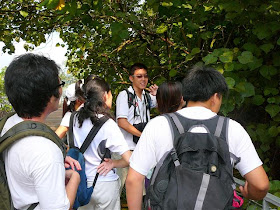
Soon we hit ourselves to the boardwalk.

We first explored the mangroves on the boardwalk which I have almost no photos except for this one as I was guiding and sharing the beauty of why the existence of mangrove is so important.
It was until much later that we caught up with the roaming Ivan who joined my group that gave me time to take photographs and be a paparazzi. There were lots of mossies at the mangroves after the rain and thus we had to walk faster. Teehee.

Of course, there is the must-take group photograph on top of the Jejawi tower where one can view Johor from this tall point. I was cheeky as I asked only the ladies what island do you think the one in front is... I got different answers (eg: P. Semakau) that were all wrong! Then I opened the question to the two gentlemen. One said its P. Tekong, the other said it's a resort. Hahahaha... so it's .. drum rolls --> "Tekong resort". Looks like that place will never leave a soldier's memory.

After the mangrove boardwalk section where we not only discovered a great deal of diversity like the different mangrove plant species including the nipah palms that their young seeds give our attap chee, we went to explore the coastal boardwalk.

Ivan started to share about the sea hibiscus that unfortunately wasn't flowering. Nevertheless, there were still ants underneath.

And also many cotton stainer bugs that feed on the seed of the sea hibiscus. This cotton stainer looks like a juvenile as it doesn't have the cross on its red body yet.

Looking downwards, there are many snails on the rocks.

What else caught our attention?

There are many of these fiddler crabs where the males have charismatic huge claws.

The claws are used to wave at the females to attract them. Supposedly, it is like we guys having big and useless things like sports car to fancy the girls.
We also saw many mud skippers that are skipping (duh) by on the shore.

Soon, we hit the coastal hill forest section of the boardwalk where we encountered several rare seashore plants like the seashore nutmeg and the pong pong tree. The pong pong tree is rare meh? Yes it is! Because the ones you find in our roadside are from Malaysia and this one here is a true blue Singaporean. :-)

Within the edge of the coastal forest are spider webs, this one with the resident spider.

No hornbill luck today though, even when Ley Kun tried hard to look for them. As this is not a zoo or birdpark visit, it's not a guarantee that we will always get to see them, next time then!

I saw this plant with interesting fruit and stalk pattern, any idea what is it?

At our last stop, we visited this visitor centre that was originally built in the 1930s by a British chief surveyor for their holiday I presume. It's an architecture beauty!

In front of the house is the jetty that stretches out with a good view of the frog island, Pulau Sekudu.

A zoom in shows the froggie rock with a drawn pair of eyes and a smily face. Haha. Interesting, there are many birds resting on the boulders at the island.
We later looked down the jetty on the shallow seagrass shore that was exposed during low tide.
Who says you can't see marine life from the boardwalk?

There was this flower crab on the shore that enchanted our attention. Apparently, there was a snapping shrimp digging sand out from its hole nearby.

I spotted a octopus! It was visible for a few second though as it later hid underneath the seaweed. Can you spot the octopus from my photo?

Our visitor friends saw a baby kite butterflyfish! Wow.
In addition, we all also saw carpet anemones, stingrays, half beaks etc etc etc just from only the boardwalk. It's wonderful to have the boardwalk as we will not trample and destroy the delicate shore. Furthermore, we can no need to get our feets wet. Hehe.

Looking down again, there were huge schools of fish!

These are the fishes (possibly juveniles) that the seagrasses support! Can you see how important this our intertidal habitat is? No mangroves/seagrasses, no seafood.

There was also a pair of the king fishers resting on the branches.

Shore birds feeding on the mudflat.

And the main star today are wild boars (Sus scrofa)! First we sighted them feeding at the mangrove shore.

Later, we saw them in the forest and there was a family of them!

They are rather tame and we could take photographs at a certain distance away.

According to the Chek Jawa online guide, wild boar are common on Pulau Ubin, including the coastal forest surrounding Chek Jawa. It's better to leave them alone if you see them as they can get aggressive when they feel threaten.
Wild boar are the wild ancestors of our domesticated pigs. Compared to domesticated pigs, Wild boar are thinner, have coarser hair and longer tusks. Males are larger than females and have sharp tusks (canine teeth).
Wild boar eat mostly fallen fruits. They also eat tubers and roots, using their mobile snouts to sniff out and dig up edibles. This video shows the wild boar crunching on something while feeding.
Very interesting trip to Chek Jawa. Glad they decided to keep Chek Jawa. I would like to visit Pulau Ubin one of these days.
ReplyDelete